Spatio-Temporal Evolution Analysis of the Urban Heat Island: A Case Study of Zhengzhou City, China
Abstract
1. Introduction
2. Materials and Methods
2.1. Study Area: Zhengzhou, China
2.2. Data
2.3. Normalized Difference Vegetation Index (NDVI) and Normalized Difference Building Index (NDBI)
2.4. LST Retrieval
2.4.1. Thermal Radiation Intensity
2.4.2. Radiation Brightness Temperature
2.4.3. Surface Emissivity
2.4.4. LST
2.5. Classification of Land Use Types
2.6. Analysis of the Profile of LST
2.7. Precision Verification
3. Results
3.1. Temporal and Spatial Variation Characteristics of LST
3.2. The Relationship between Land Use and LST
3.2.1. The Relationship between NDVI and LST
3.2.2. The Relationship between NDBI and LST
3.3. The Relationship between Socio-Economic Factors and LST
4. Discussion
4.1. Land Use/Land Cover (LULC) Has a Strong Driving Effect on LST
4.2. The Driving Effect of Socio-Economic Factors on LST
4.3. Implications
- (1)
- Improve the coverage rate of urban greening. On the basis of controlling the cost, increase public facilities reasonably, such as green parks, forest parks, the road green belt and so on, and encourage residents to build green roofs at the same time.
- (2)
- Seek a reasonable scale, structure, system and spatial layout for urban land use. We should reverse the traditional expansion model of single-center cities, actively push forward the construction of multi-center cities, and reasonably control the total scale of built-up areas.
- (3)
- The UHI is mainly formed by the joint action of urbanization and industrialization. Controlling the energy consumption and urban economic development intensity and controlling the total population and reasonable distribution are important measures to effectively curb the UHI effect in Zhengzhou City. At the same time, proper control of the incremental development of urban real estate and high-rise buildings is also important to effectively curb the heat island effect.
- (4)
- Actively develop new energy technology. The large amount of heat energy emitted by human beings is the most important drivers of the UHI effect. Therefore, we should promote the use of new energy sources and the continuous development of new energy sources, such as wind and solar energy. It is important to reduce the use of non-renewable energy sources, such as coal and gasoline in order to reduce atmospheric pollution and human energy emissions.
5. Conclusions
Author Contributions
Funding
Acknowledgments
Conflicts of Interest
References
- Howard, L. The Climate of London; W. Phillips: London, UK, 1818. [Google Scholar]
- Manley, G. On the frequency of snowfall in metropolitan England. Q. J. R. Meteorol. Soc. 1958, 84, 70–72. [Google Scholar] [CrossRef]
- Zhou, S.Z.; Su, J. Urban Climatology; China Meteorological Press: Beijing, China, 1994. [Google Scholar]
- Grimm, N.B.; Faeth, S.H.; Golubiewski, N.E.; Redman, C.L.; Wu, J.G.; Bai, X.M.; Briggs, J.M. Global change and the ecology of cities. Science 2008, 319, 756–760. [Google Scholar] [CrossRef] [PubMed]
- Chang, C.R.; Li, M.H.; Chang, S.D. A preliminary study on the local cool-island intensity of Taipei city parks. Landsc. Urban Plan. 2007, 80, 386–395. [Google Scholar] [CrossRef]
- Zhou, L.; Dickinson, R.E.; Tian, Y.; Fang, J.; Li, Q.; Kaufmann, R.K.; Tucker, C.J.; Myneni, R.B. Evidence for a significant urbanization effect on climate in China. Proc. Natl. Acad. Sci. USA 2004, 101, 9540–9544. [Google Scholar] [CrossRef] [PubMed]
- Patz, J.A.; Campbelllendrum, D.; Holloway, T.; Foley, J.A. Impact of regional climate change on human health. Nature 2005, 438, 310–317. [Google Scholar] [CrossRef] [PubMed]
- Yu, X.X.; Yang, G.S.; Wang, Y. Advance in researches on environmental effects of Land Use/Cover change. Sci. Geogr. Sin. 2004, 24, 627–633. [Google Scholar]
- Rao, P.K. Remote sensing of urban “heat islands” from an environmental satellite. Bull. Am. Meteorol. Soc. 1972, 53, 647–648. [Google Scholar]
- Gallo, K.P.; Mcnab, A.L.; Karl, T.R.; Brown, J.F.; Hood, J.J.; Tarpley, J.D. The use of a vegetation index for assessment of the ubran heat island effect. Int. J. Remote Sens. 1993, 14, 2223–2230. [Google Scholar] [CrossRef]
- Stathopoulou, M.; Cartalis, C. Downscaling AVHRR land surface temperatures for improved surface urban heat island intensity estimation. Remote Sens. Environ. 2009, 113, 2592–2605. [Google Scholar] [CrossRef]
- Vancutsem, C.; Ceccato, P.; Dinku, T.; Connor, S.J. Evaluation of modis land surface temperature data to estimate air temperature in different ecosystems over Africa. Remote Sens. Environ. 2010, 114, 449–465. [Google Scholar] [CrossRef]
- Wan, Z. New refinements and validation of the MODIS Land-Surface Temperature/Emissivity products. Remote Sens. Environ. 2014, 140, 36–45. [Google Scholar] [CrossRef]
- Liu, Y. A new approach to reduce inconsistency between MODIS and ASTER land surface temperature products. In Remote Sensing for Agriculture, Ecosystems, and Hydrology VIII; SPIE Remote Sensing; SPIE: Bellingham, WA, USA, 2006; Volume 6359. [Google Scholar]
- Shohei, K.; Takeki, I.; Hideo, T. Relationship between Terra/ASTER Land Surface Temperature and Ground-observed Air Temperature. Geogr. Rev. Jpn. 2016, 88, 38–44. [Google Scholar] [CrossRef]
- Cai, G.Y.; Du, M.Y.; Xue, Y. Monitoring of urban heat island effect in Beijing combining ASTER and TM data. Int. J. Remote Sens. 2011, 32, 1213–1232. [Google Scholar] [CrossRef]
- Nichol, J. An emissivity modulation method for spatial enhancement of thermal satellite images in urban heat island analysis. Photogramm. Eng. Remote Sens. 2009, 75, 547–556. [Google Scholar] [CrossRef]
- Wu, H.; Ye, L.P.; Shi, W.Z.; Clarke, K.C. Assessing the effects of land use spatial structure on urban heat islands using HJ-1B remote sensing imagery in Wuhan, China. Int. J. Appl. Earth Obs. Geoinf. 2014, 32, 67–78. [Google Scholar] [CrossRef]
- Li, W.; Sun, Y.; Meng, D.; Li, X. Analysis of Beijing’s urban heat-island under the influence of extrme heat based on HJ-1B data. In Proceedings of the 2013 IEEE International Geoscience and Remote Sensing Symposium, Melbourne, Australia, 21–26 July 2013; pp. 3845–3848. [Google Scholar]
- Qin, Z.H.; Karnieli, A.; Berliner, P. A mono-window algorithm for retrieving land surface temperature from Landsat TM data and its application to the Israel-Egypt Border Region. Int. J. Remote Sens. 2001, 22, 3719–3746. [Google Scholar] [CrossRef]
- Estoque, R.C.; Murayama, Y. Classification and change detection of built-up lands from Landsat-7 ETM+ and Landsat-8 OLI/TIRS imageries: A comparative assessment of various spectral indices. Ecol. Indic. 2015, 56, 205–217. [Google Scholar] [CrossRef]
- Bektas, B.F.; Mujgan, E.E. Land Surface Temperature Retrieval from Landsat 8 TIRS—A Case Study of Istanbul. In Proceedings of the EGU General Assembly Conference Abstracts, Vienna Austria, 17–22 April 2016. [Google Scholar]
- Kustas, W.P.; Nieto, H.; Morillas, L.; Anderson, M.C.; Alfieri, J.G.; Hipps, L.E.; Villagarcía, L.; Domingo, F.; Garcia, M. Using radiometric surface temperature for surface energy flux estimation in Mediterranean drylands from a two-source perspective. Remote Sens. Environ. 2013, 136, 234–246. [Google Scholar] [CrossRef]
- Zou, D.; Zhao, L.; Wu, T.; Wu, X.; Pang, Q.; Wang, Z. Modeling ground surface temperature by means of remote sensing data in high-altitude areas: Test in the central Tibetan Plateau with application of moderate-resolution imaging spectroradiometer Terra/Aqua land surface temperature and ground-based infrared. Appl. Remote Sens. 2014, 8, 083516. [Google Scholar] [CrossRef]
- Zhong, S.; Qian, Y.; Zhao, C.; Leung, R.; Wang, H.L.; Yang, B.; Fan, J.W.; Yan, H.P.; Yang, X.Q.; Liu, D.Q. Urbanization-induced urban heat island and aerosol effects on climate extremes in the Yangtze River Delta region of China. Atmos. Chem. Phys. 2017, 17, 1–57. [Google Scholar] [CrossRef]
- Carlson, T.N.; Arthur, S.T. The impact of use-land cover changes due to urbanization on surface microclimate and hydrology. As satellite perspective. Glob. Planet. Chang. 2000, 25, 49–65. [Google Scholar] [CrossRef]
- Rotem-Mindali, O.; Michael, Y.; Helman, D.; Lensky, I.M. The role of local land-use on the urban heat island effect of Tel Aviv as assessed from satellite remote sensing. Appl. Geogr. 2015, 56, 145–153. [Google Scholar] [CrossRef]
- Estoque, R.C.; Murayama, Y.; Myint, S.W. Effects of landscape composition and pattern on land surface temperature: An urban heat island study in the megacities of Southeast Asia. Sci. Total Environ. 2017, 577, 349–359. [Google Scholar] [CrossRef] [PubMed]
- Asgarian, A.; Amiri, B.J.; Sakieh, Y. Assessing the effect of green cover spatial patterns on urban land surface temperature using landscape metrics approach. Urban Ecosyst. 2015, 18, 209–222. [Google Scholar] [CrossRef]
- Weng, Q.H.; Yang, S.H. Managing the adverse thermal effects of urban development in a densely populated Chinese city. J. Environ. Manag. 2004, 70, 145–156. [Google Scholar] [CrossRef]
- Kotharkar, R.; Surawar, M. Land Use, Land Cover, and Population Density Impact on the Formation of Canopy Urban Heat Islands through Traverse Survey in the Nagpur Urban Area, India. J. Urban Plan. Dev. 2016, 142, 04015003. [Google Scholar] [CrossRef]
- Zhang, J.Y.; Wu, L.Y. Modulation of the urban heat island by the tourism during the Chinese New Year holiday: A case study in Sanya City, Hainan Province of China. Sci. Bull. 2015, 60, 1543–1546. [Google Scholar] [CrossRef]
- Zhang, H.; Qi, Z.F.; Ye, X.Y.; Cai, Y.B.; Ma, W.C.; Chen, M.N. Analysis of land use/land cover change, population shift, and their effects on spatiotemporal patterns of urban heat islands in metropolitan Shanghai, China. Appl. Geogr. 2013, 44, 121–133. [Google Scholar] [CrossRef]
- Peng, B.; Shi, Y.; Wang, H.; Wang, Y. The impacting mechanism and laws of function of urban heat island effect:A case study of Shanghai. Acta Eeogr. Sin. 2013, 68, 1461–1471. [Google Scholar]
- Raynolds, M.K.; Comiso, J.C.; Walker, D.A.; Verbyla, D. Relationship between satellite-derived land surface temperatures, arctic vegetation types, and NDVI. Remote Sens. Environ. 2008, 112, 1884–1894. [Google Scholar] [CrossRef]
- Yuan, F.; Bauer, M.E. Comparison of impervious surface area and normalized difference vegetation index as indicators of surface urban heat island effects in Landsat imagery. Remote Sens. Environ. 2007, 106, 375–386. [Google Scholar] [CrossRef]
- Bokaie, M.; Zarkesh, M.K.; Arasteh, P.D.; Hosseini, A. Assessment of Urban Heat Island based on the relationship between land surface temperature and Land Use/Land Cover in Tehran. Sustain. Cities Soc. 2016, 23, 94–104. [Google Scholar] [CrossRef]
- Xiao, R.B.; Ouyang, Z.Y.; Zheng, H.; Li, W.F.; Schienke, E.W.; Wang, X.K. Spatial pattern of impervious surfaces and their impacts on land surface temperature in Beijing. Chin. J. Environ. Sci. 2007, 19, 250–256. [Google Scholar] [CrossRef]
- Zhang, X.; Estoque, R.C.; Murayama, Y. An urban heat island study in Nanchang City, China based on land surface temperature and social-ecological variables. Sustain. Cities Soc. 2017, 32, 557–568. [Google Scholar] [CrossRef]
- Morais, M.V.B.; Freitas, E.D.; Urbina Guerrero, V.V.; Martins, L.D. A modeling analysis of urban canopy parameterization representing the vegetation effects in the megacity of São Paulo. Urban Clim. 2016, 17, 102–115. [Google Scholar] [CrossRef]
- Lemonsu, A.; Masson, V.; Shashuabar, L.; Erell, E.; Pearlmutter, D. Inclusion of vegetation in the Town Energy Balance model for modeling urban green areas. Geosci. Model Dev. Discuss. 2012, 5, 1295–1340. [Google Scholar] [CrossRef]
- Lee, D.; Woo, J.; Lee, S.H. An analytically-based numerical method for computing view factors in real urban environments. Theor. Appl. Climatol. 2018, 131, 445–453. [Google Scholar] [CrossRef]
- Ogashawara, I.; Bastos, V.D.S.B. A Quantitative Approach for Analyzing the Relationship between Urban Heat Islands and Land Cover. Remote Sens. 2012, 4, 3596–3618. [Google Scholar] [CrossRef]
- Chun, B.; Guldmann, J.M. Spatial statistical analysis and simulation of the urban heat island in high-density central cities. Landsc. Urban Plan. 2014, 125, 76–88. [Google Scholar] [CrossRef]
- Chen, X.L.; Zhao, H.M.; Li, P.X.; Yin, Z.Y. Remote sensing image-based analysis of the relationship between urban heat island and land use/cover changes. Remote Sens. Environ. 2006, 104, 133–146. [Google Scholar] [CrossRef]
- Gao, B.C. NDWI-A normalized difference water index for remote sensing of vegetation liquid water from space. Remote Sens. Environ. 1996, 58, 257–266. [Google Scholar] [CrossRef]
- Sheng, L.; Lu, D.S.; Huang, J.F. Impacts of land-cover types on an urban heat island in Hangzhou, China. Int. J. Remote Sens. 2015, 36, 1584–1603. [Google Scholar] [CrossRef]
- Luo, X.; Peng, Y. Scale Effects of the Relationships between Urban Heat Islands and Impact Factors Based on a Geographically-Weighted Regression Model. Remote Sens. 2016, 8, 760. [Google Scholar] [CrossRef]
- Du, H.; Song, X.; Jiang, H.; Kan, Z.; Wang, Z.; Cai, Y. Research on the cooling island effects of water body: A case study of Shanghai, China. Ecol. Indic. 2016, 67, 31–38. [Google Scholar] [CrossRef]
- Han, S.R.; Wei, S.; Zhou, W.; Zhang, M.J.; Tao, T.T.; Oiu, L.; Liu, M.S.; Xu, C. Quantifying the spatial pattern of urban thermal fields based on point of interest data and Landsat images. Sci. Geogr. Sin. 2017, 37, 5305–5312. [Google Scholar]
- Ranagalage, M.; Stock, R.C.; Murayama, Y. An Urban Heat Island Study of the Colombo Metropolitan Area, Sri Lanka, Based on Landsat Data (1997–2017). ISPRS Int. J. Geo-Inf. 2017, 6, 189. [Google Scholar] [CrossRef]
- Yue, W.Z.; Xu, J.H. Impact of Human Activities on Urban Thermal Environment in Shanghai. Sci. Geogr. Sin. 2008, 63, 247–256. [Google Scholar]
- He, X.F.; Jiang, W.M.; Chen, Y.; Liu, G. Numerical simulation of the impacts of anthropogenic heat on the structure of the urban boundary layer. Chin. J. Geophys. 2007, 50, 75–83. [Google Scholar] [CrossRef]
- Zhang, J.; Wu, L.; Yuan, F.; Dou, J.; Miao, S. Mass human migration and Beijing’s urban heat island during the Chinese New Year holiday. Sci. Bull. 2015, 60, 1038–1041. [Google Scholar] [CrossRef]
- Wu, L.Y.; Zhang, J.Y.; Shi, C.X. Mass Human Migration and the Urban Heat Island during the Chinese New Year Holiday: A Case Study in Harbin City, Northeast China. Atmos. Ocean. Sci. Lett. 2015, 8, 63–66. [Google Scholar]
- Zhengzhou Statistical Yearbook; China Statistics Press: Beijing, China, 2015.
- Bernabé, A.; Musy, M.; Andrieu, H.; Calmet, I. Radiative properties of the urban fabric derived from surface form analysis: A simplified solar balance model. Sol. Energy 2015, 122, 156–168. [Google Scholar] [CrossRef]
- Morais, M.V.B.; Marciotto, E.R.; Urbina Guerrero, V.V.; Freitas, E.D. Effective albedo estimates for the Metropolitan Area of São Paulo using empirical sky-view factors. Urban Clim. 2017, 21, 183–194. [Google Scholar] [CrossRef]
- Xie, M.M.; Wang, Y.L.; Fu, M.C. An overview and perspective about Causative factors of surface urban heat island effects. Prog. Geogr. 2011, 30, 35–41. [Google Scholar]
- Statistical Communiqu for Zhengzhou’s National Economic and Social Development in 2016. Available online: http://tjj.zhengzhou.gov.cn/tjgb/418270. jhtml (accessed on 20 April 2018).
- USGS (United States Geological Survey). Available online: http://earthexplorer.usgs.gov/ (accessed on 20 April 2018).
- Zhengzhou Statistical Yearbook; China Statistics Press: Beijing, China, 2001.
- Zhengzhou Statistical Yearbook; China Statistics Press: Beijing, China, 2007.
- Zhengzhou Statistical Yearbook; China Statistics Press: Beijing, China, 2011.
- Purevdorj, T.; Tateishi, R.; Ishiyama, T.; Hondaet, Y. Relationships between percent vegetation cover and vegetation indices. Int. J. Remote Sens. 1998, 19, 3519–3535. [Google Scholar] [CrossRef]
- Weng, Q.; Lu, D.S.; Schubring, J. Estimation of land surface temperature—Vegetation abundance relationship urban heat island studies. Remote Sens. Environ. 2004, 89, 467–483. [Google Scholar] [CrossRef]
- Sobrino, J.A.; Jiménez-Muñoz, J.C.; Paolini, L. Land surface temperature retrieval from LANDSAT TM 5. Remote Sens. Environ. 2004, 90, 434–440. [Google Scholar] [CrossRef]
- Vlassova, L.; Perezcabello, F.; Nieto, H.; Martín, P.; Riaño, D.; Riva, J.D.L. Assessment of Methods for Land Surface Temperature Retrieval from Landsat-5 TM Images Applicable to Multiscale Tree-Grass Ecosystem Modeling. Remote Sens. 2014, 6, 4345–4368. [Google Scholar] [CrossRef]
- Benmecheta, A.; Abdellaoui, A.; Hamou, A. A comparative study of land surface temperature retrieval methods from. Can. J. Remote Sens. 2013, 39, 59–73. [Google Scholar]
- Zha, Y.; Gao, J.; Ni, S. Use of normalized difference built-up index in automatically mapping urban areas from TM imagery. Int. J. Remote Sens. 2003, 24, 583–594. [Google Scholar] [CrossRef]
- Liu, H.; Weng, Q. Enhancing temporal resolution of satellite imagery for public health studies: A case study of West Nile Virus outbreak in Los Angeles in 2007. Remote Sens. Environ. 2012, 117, 57–71. [Google Scholar] [CrossRef]
- Kikon, N.; Singh, P.; Singh, S.K.; Vyas, A. Assessment of urban heat islands (UHI) of Noida City, India using multi-temporal satellite data. Sustain. Cities Soc. 2016, 22, 19–28. [Google Scholar] [CrossRef]
- Zhao, S.Y. Principle and Method of Remote Sensing Application Analysis; The Science Publishing Company: Beijing, China, 2003. [Google Scholar]
- Mei, A.X. Introduction of Remote Sensing; Higher Education Press: Beijing, China, 2001. [Google Scholar]
- Artis, D.A.; Carnahan, W.H. Survey of emissivity variability in thermography of urban areas. Remote Sens. Environ. 1982, 12, 313–329. [Google Scholar] [CrossRef]
- Kan, Z.; Liu, C.; Zhou, C. Comparative analysis of land surface emissivity retrieval methods and the impact on the land surface temperature based on Landsat-8 thermal infrared data. In Remote Sensing and Modeling of Ecosystems for Sustainability XII; Optical Engineering + Applications; SPIE: Bellingham, WA, USA, 2015; Volume 961012. [Google Scholar]
- Na, Y.T. Study on the Application and Comparative Analysis of Land Surface Temperature Retrieval Method Based on Multi-Sensor Remote Sensing Data. Adv. Mater. Res. 2014, 1010–1012, 1276–1279. [Google Scholar] [CrossRef]
- Liu, J.Y.; Zhang, Z.X.; Zhuang, D.F.; Zhang, S.W.; Li, X.B. Spatio Temporal Information of Land Use Change in China in 1990s; Science Press: Beijing, China, 1994. [Google Scholar]
- Kerr, Y.H.; Lagouarde, J.P.; Nerry, F.; Ottlé, C.; Quattrochi, D.A.; Luvall, J.C. Land surface temperature retrieval techniques and applications. In Thermal Remote Sensing in Land Surface Processing; CRC Press: Boca Raton, FL, USA, 2000; pp. 33–109. [Google Scholar]
- China Meteorological Administration. Available online: http://www.cma.gov.cn/2011qxfw/2011qsjcx/ (accessed on 20 April 2018).
- Kalnay, E.; Cai, M. Impact of urbanization and land-use change on climate. Nature 2003, 423, 528–531. [Google Scholar] [CrossRef] [PubMed]
- Zhang, H.F.; Wang, Y.L.; Wu, J.S.; Li, W.F.; Li, Z.G. Study on land surface temperature vegetation cover relationship in urban region:a case in Shenzhen City. Geogr. Res. 2006, 25, 369–377. [Google Scholar]
- Huang, R.F.; Xu, H.Q. A study on the relationship between land cover/use and urban heat environment using Landsat ETM+ satellite imagery. Remote Sens. Inf. 2005, 0, 36–39. [Google Scholar]
- Gao, X.; Wu, G.X.; Du, G.Y.; Li, C.P.; Shen, H.F. A Spatio-temporal changes of thermal landscape pattern based on a multifractal model: A case study of Zhengzhou City. Acta Ecol. Sin. 2015, 35, 6774–6787. [Google Scholar]
- Rhee, J.; Park, S.; Lu, Z. Relationship between land cover patterns and surface temperature in urban areas. Map. Sci. Remote Sens. 2014, 51, 521–536. [Google Scholar] [CrossRef]
- Zhao, Z.C. The changes of temperature and the effects of the urbanization in China in the last 39 years. Meteorol. Mon. 1991, 17, 14–17. [Google Scholar]
- Ren, G.Y.; Xu, M.Z.; Chu, Z.Y.; Guo, J.; Li, Q.X.; Liu, X.N.; Wang, Y. Change of surface air temperature in China during 1951–2004. Clim. Environ. Res. 2005, 10, 717–727. [Google Scholar]
- Su, Y.F.; Foody, G.M.; Cheng, K.S. Spatial non-stationarity in the relationships between land cover and surface temperature in an urban heat island and its impacts on thermally sensitive populations. Landsc. Urban Plan. 2012, 107, 172–180. [Google Scholar] [CrossRef]
- Wang, J.; Huang, B.; Fu, D.; Atkinson, P.M. Spatiotemporal Variation in Surface Urban Heat Island Intensity and Associated Determinants across Major Chinese Cities. Remote Sens. 2015, 7, 3670–3689. [Google Scholar] [CrossRef]
- Yao, R.; Wang, L.; Huang, X.; Niu, Z.; Liu, F.; Wang, Q. Temporal trends of surface urban heat islands and associated determinants in major Chinese cities. Sci. Total Environ. 2017, 609, 742. [Google Scholar] [CrossRef] [PubMed]
- Du, S.; Wang, Q.; Guo, L. Spatially varying relationships between land-cover change and driving factors at multiple sampling scales. J. Environ. Manag. 2014, 137, 101–110. [Google Scholar] [CrossRef] [PubMed]
- Luo, X. Scale effect analysis of the relationships between urban heat island and impact factors: Case study in Chongqing. J. Appl. Remote Sens. 2014, 8, 284–292. [Google Scholar] [CrossRef]
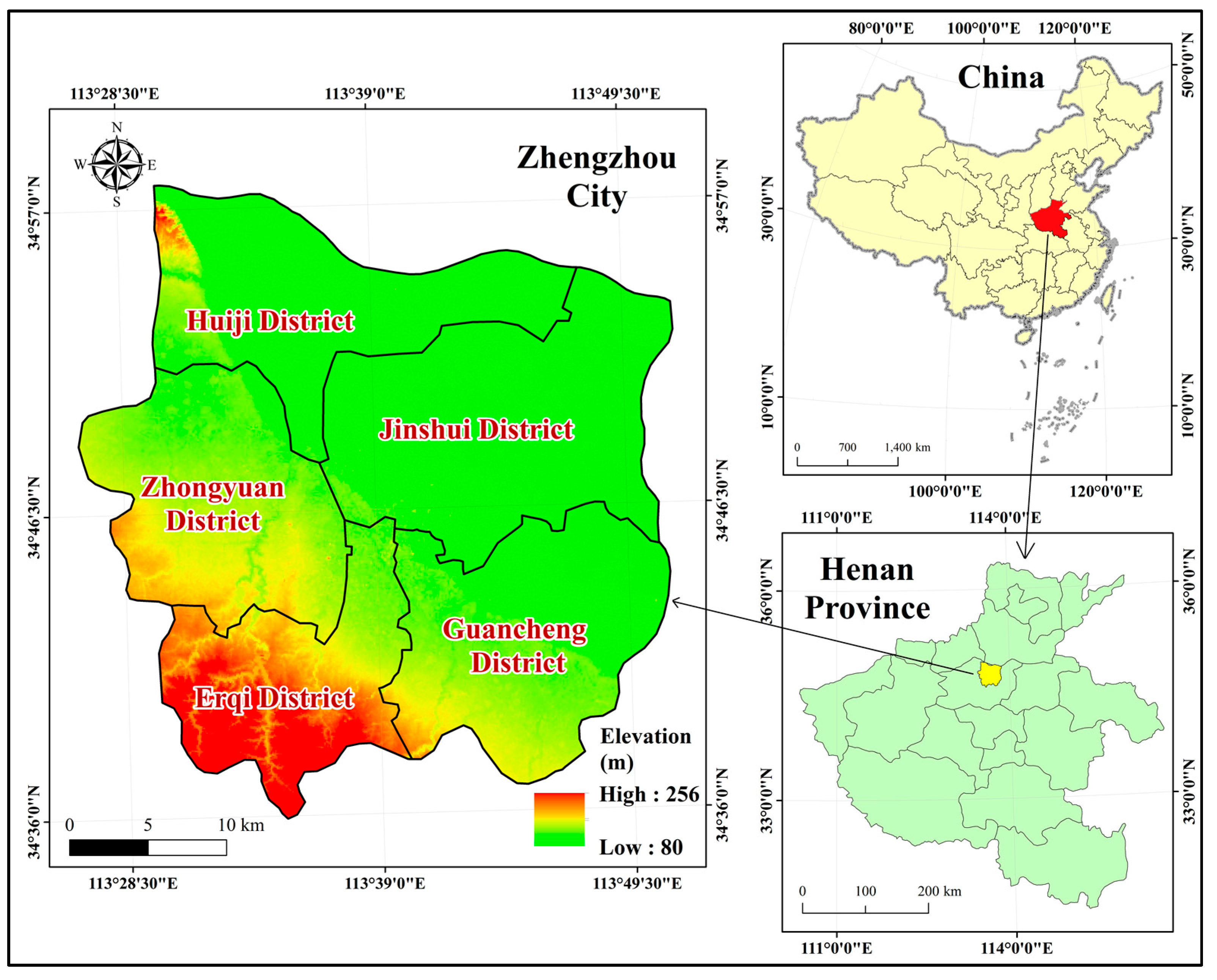
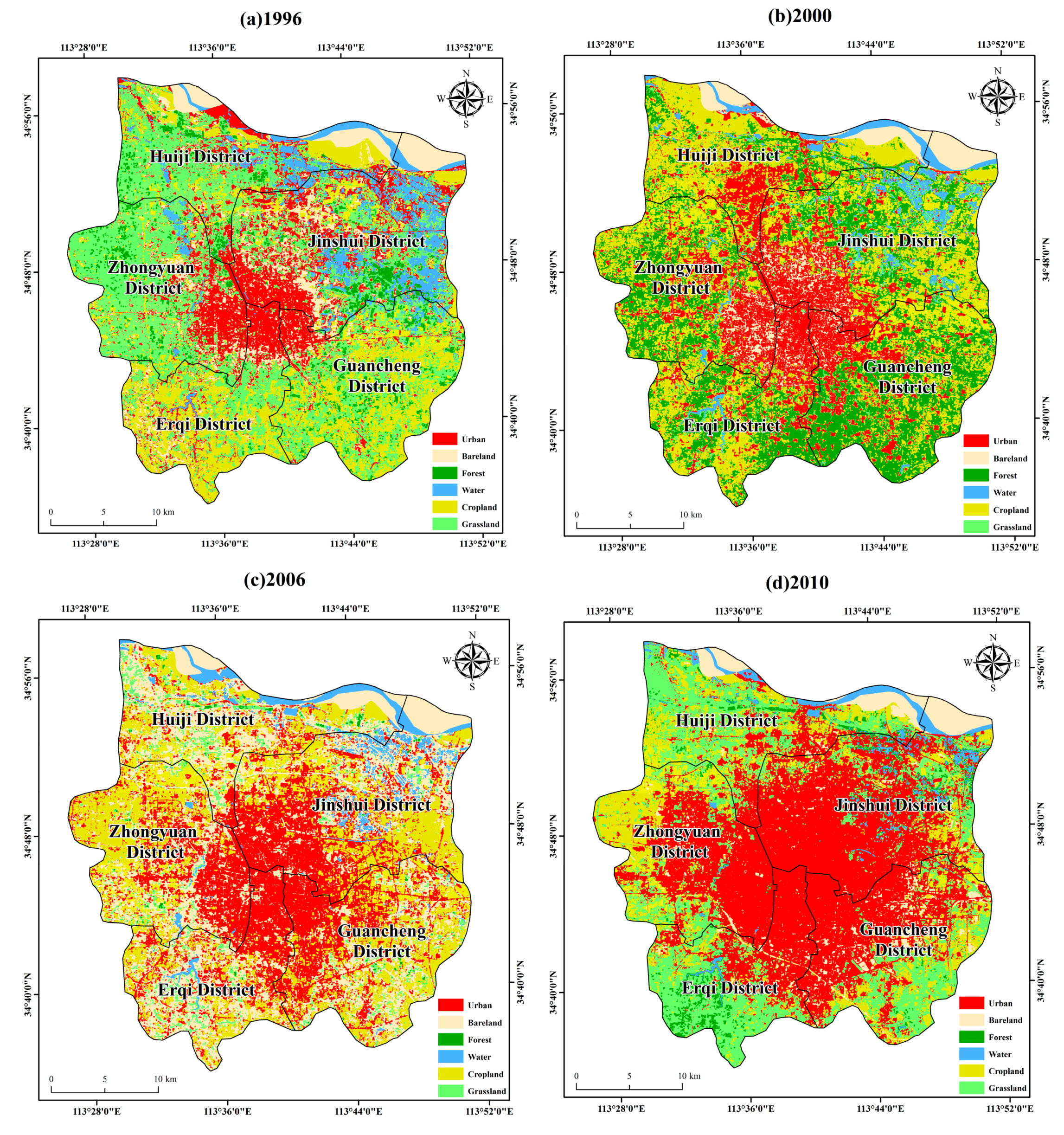
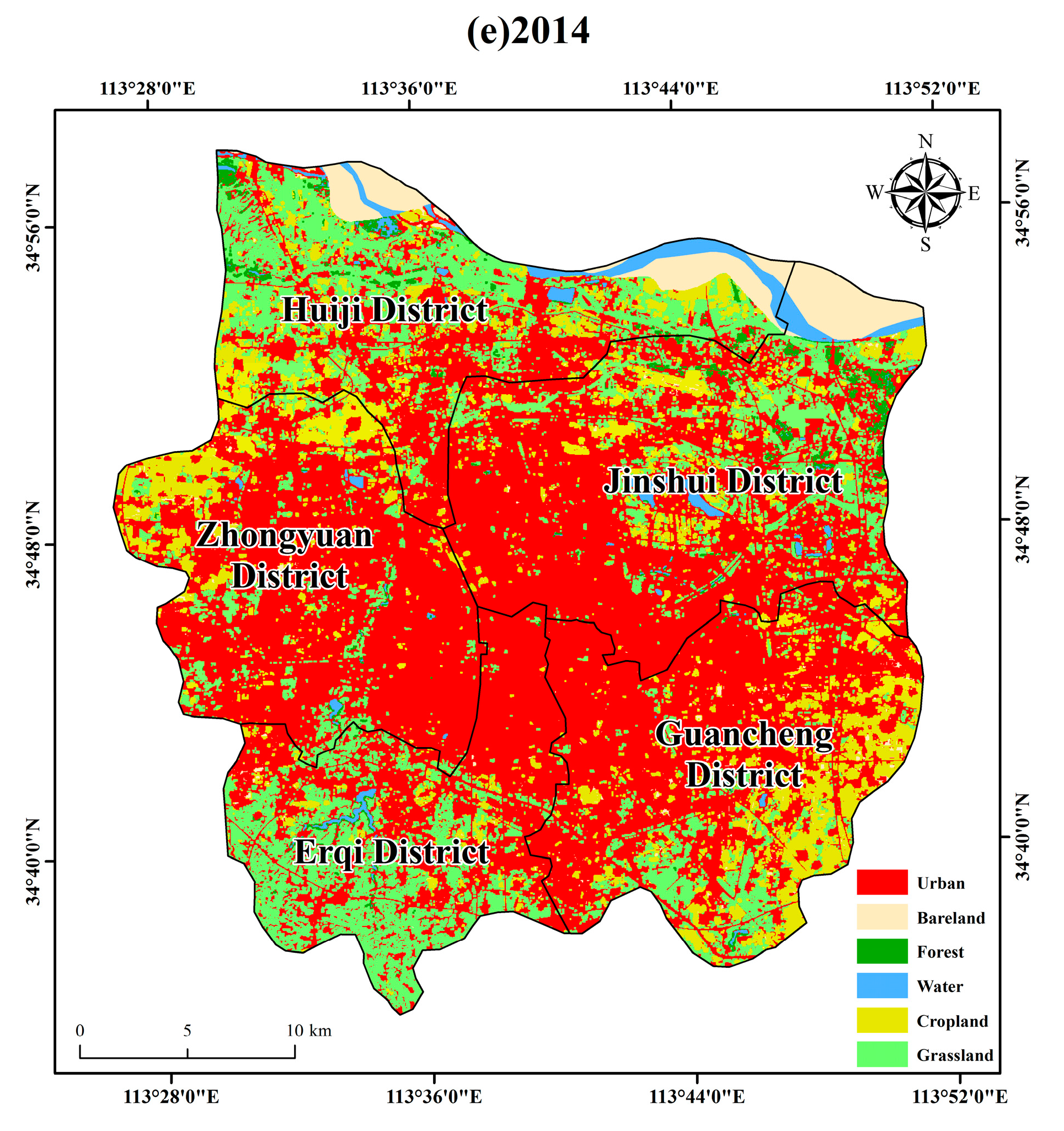
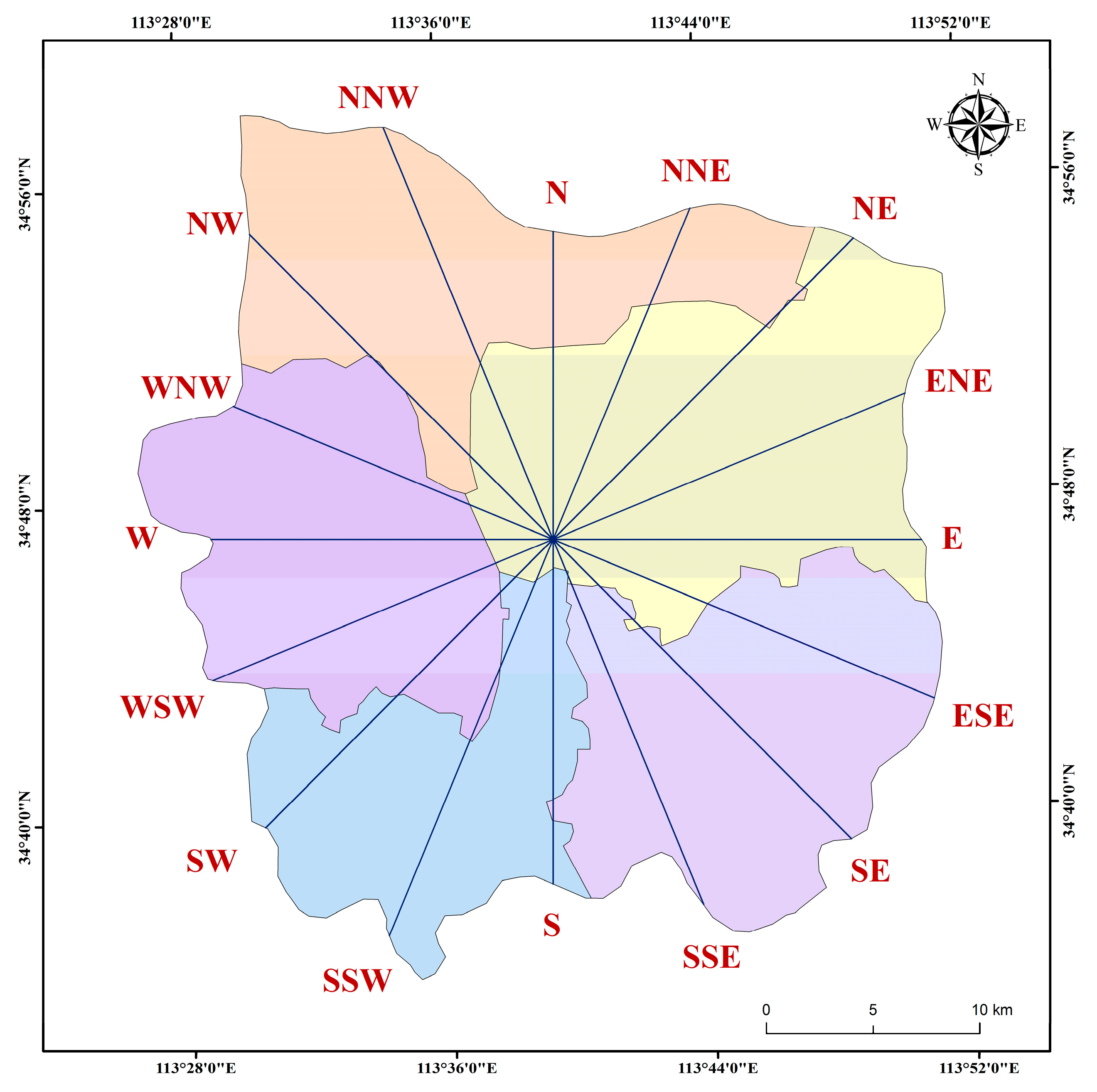
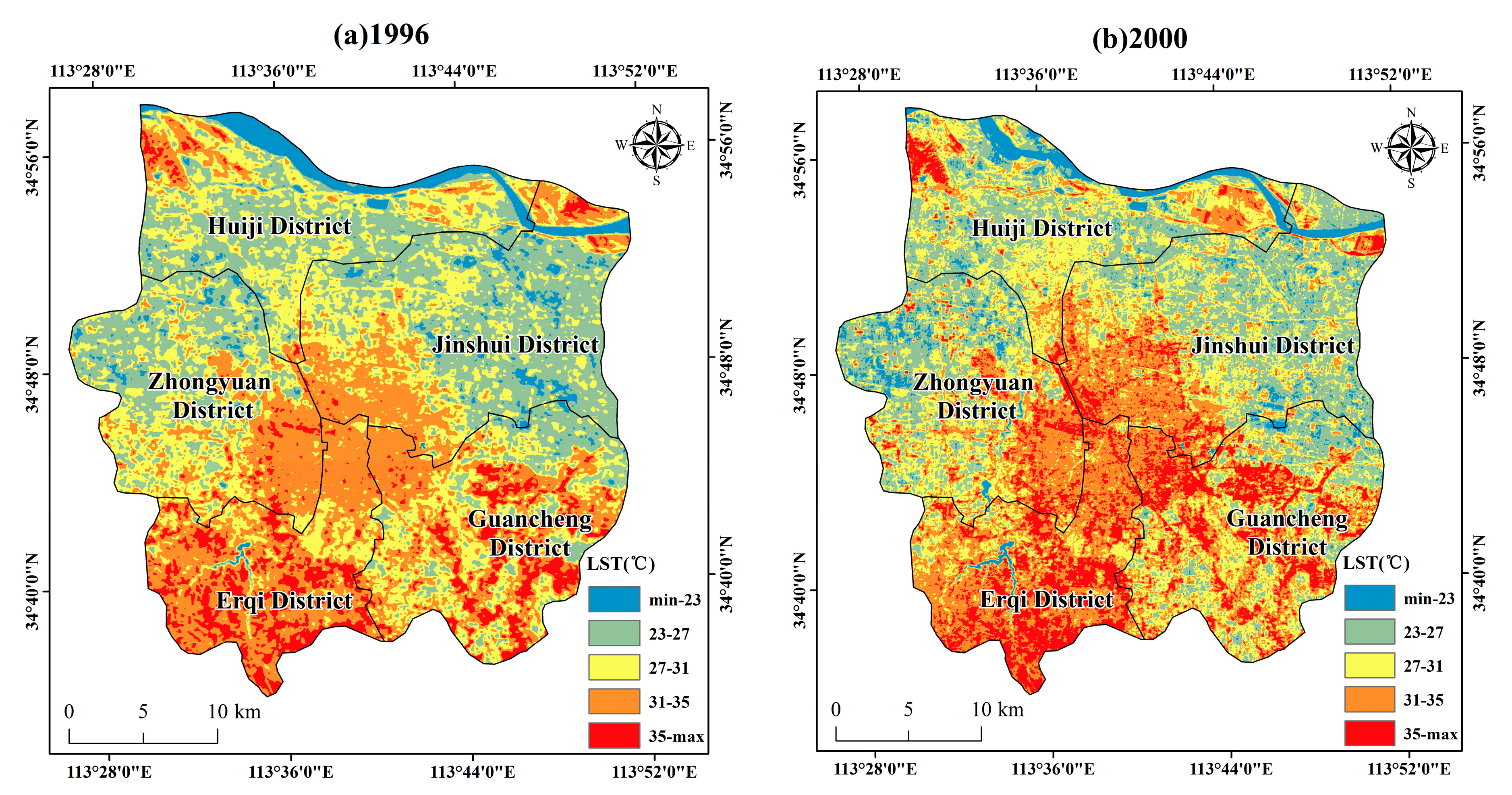
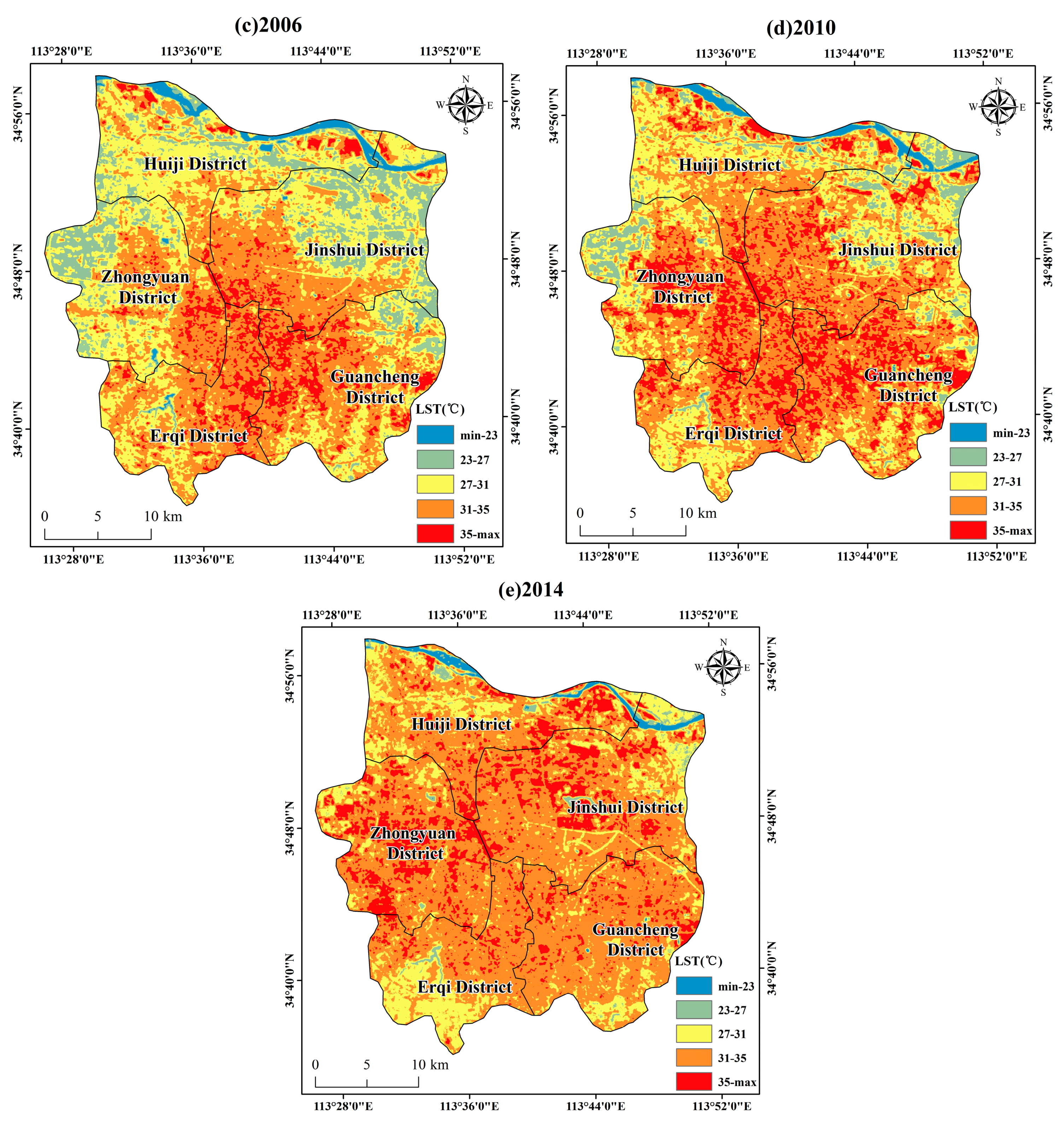
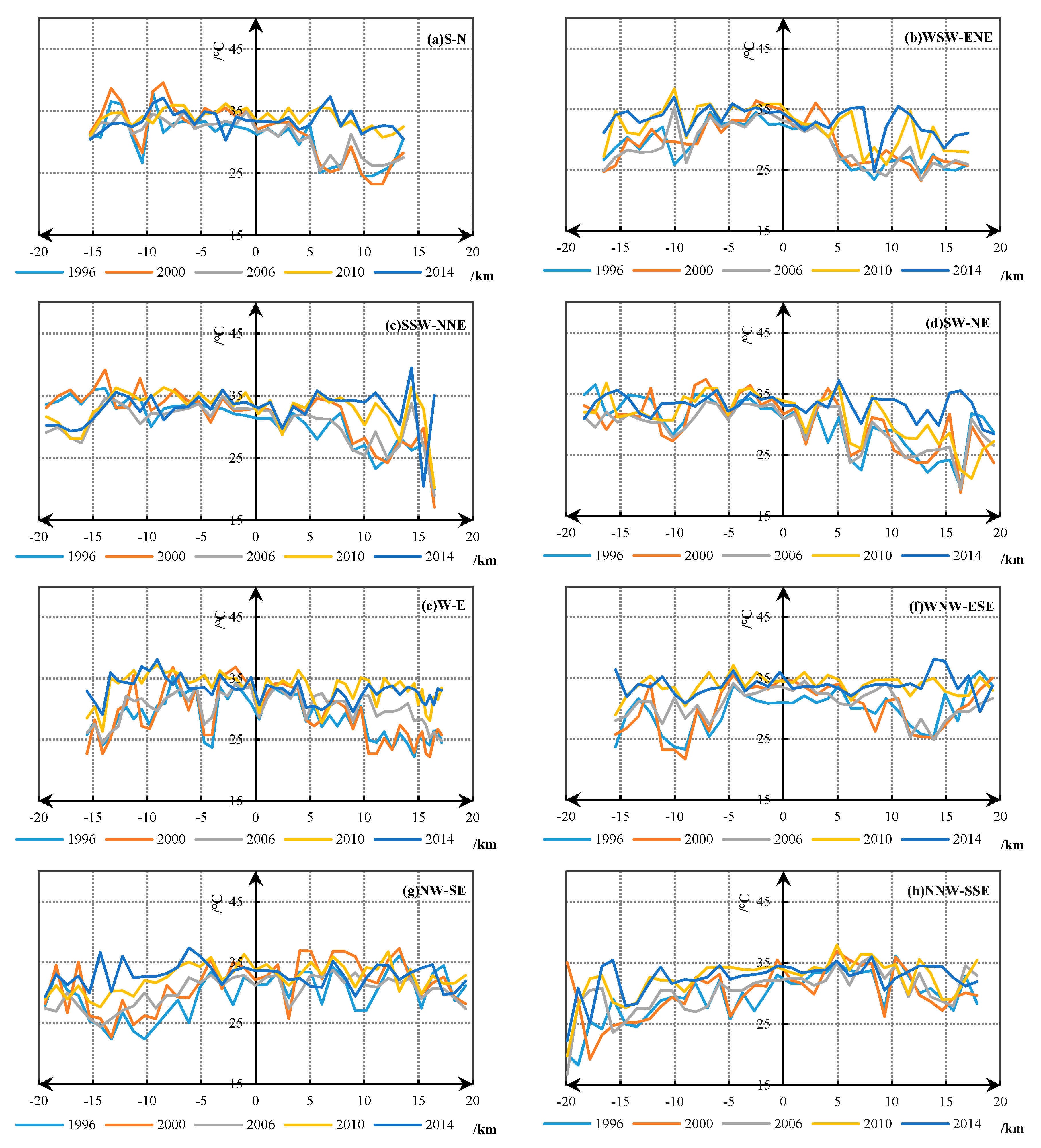
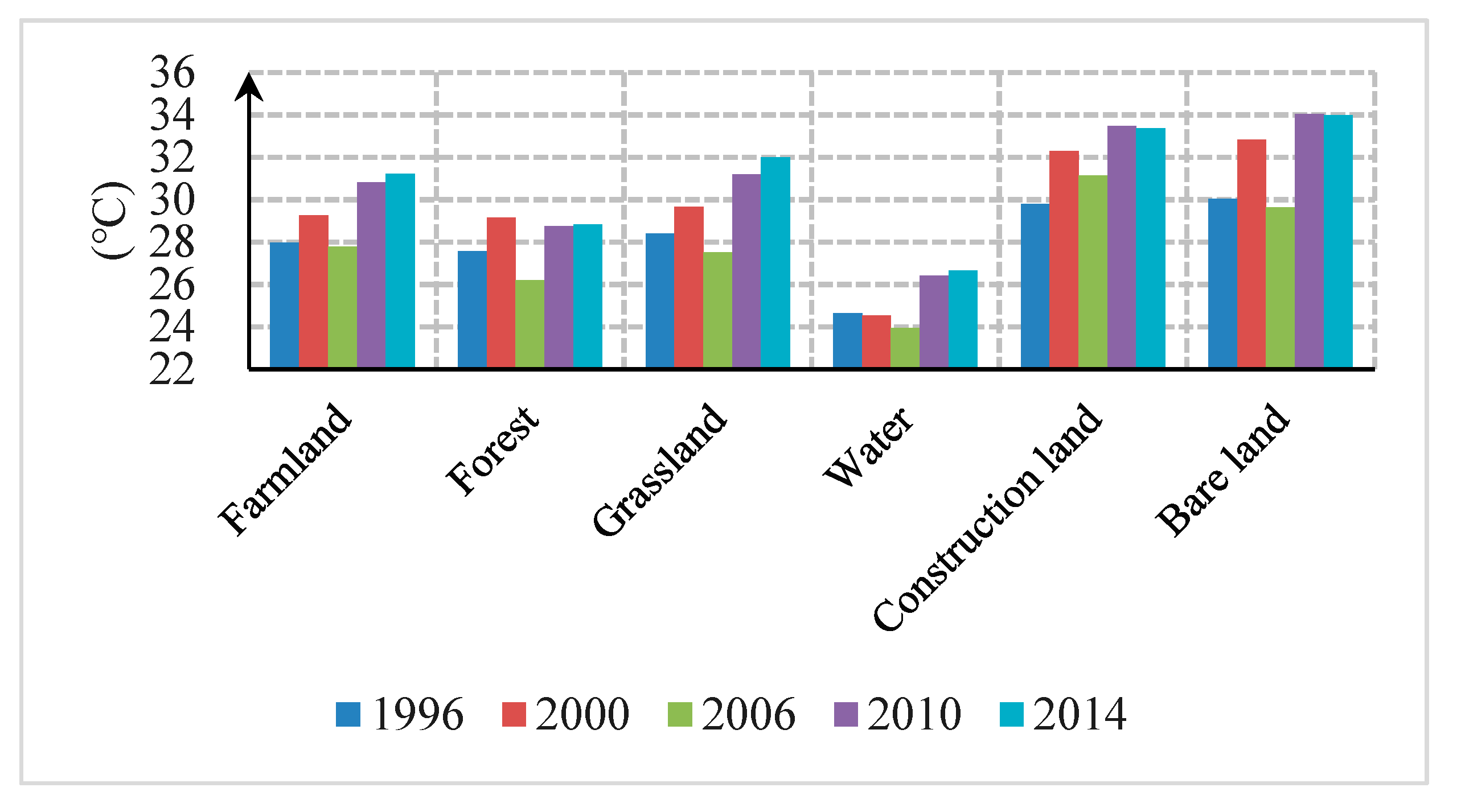
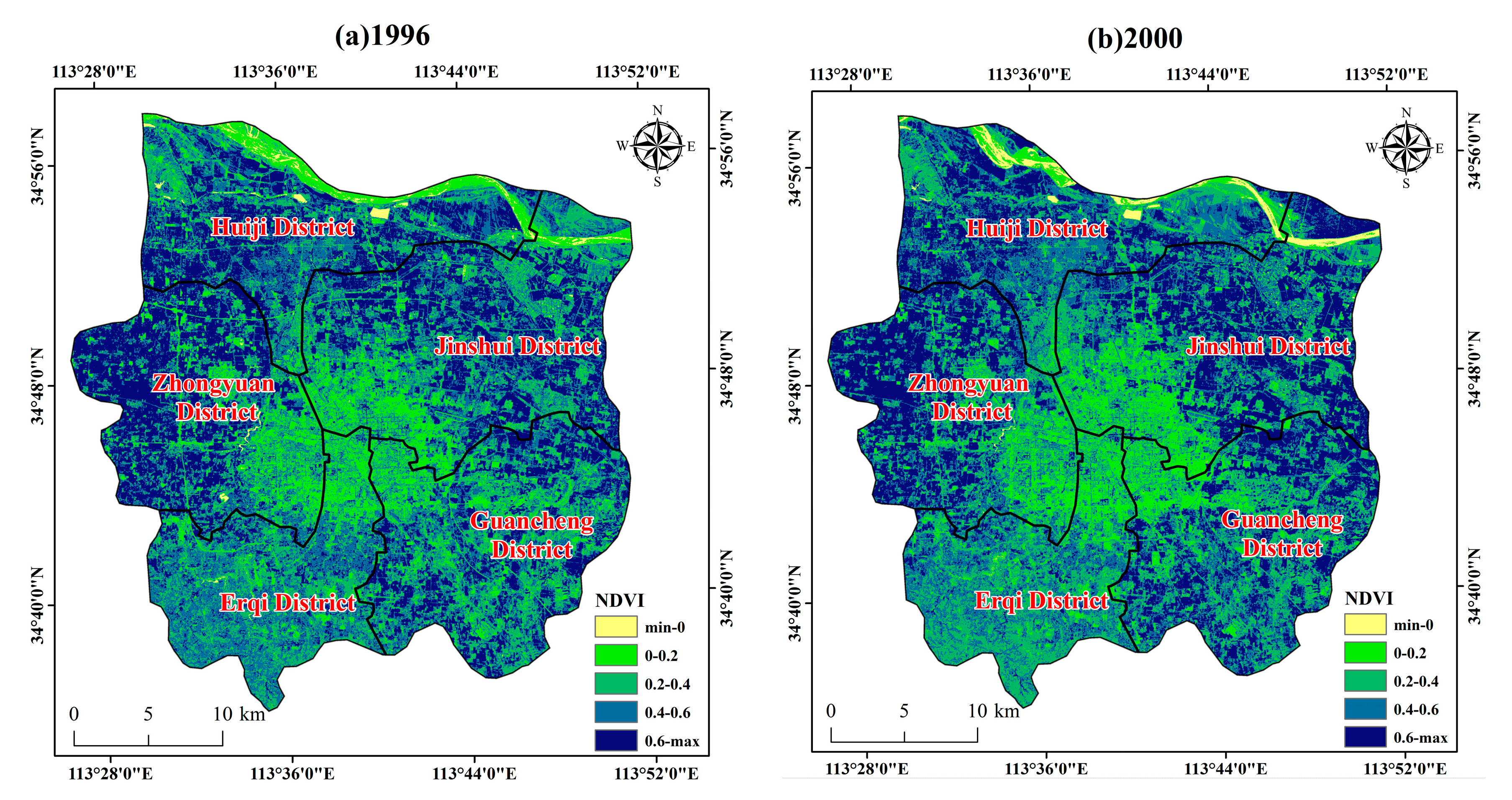
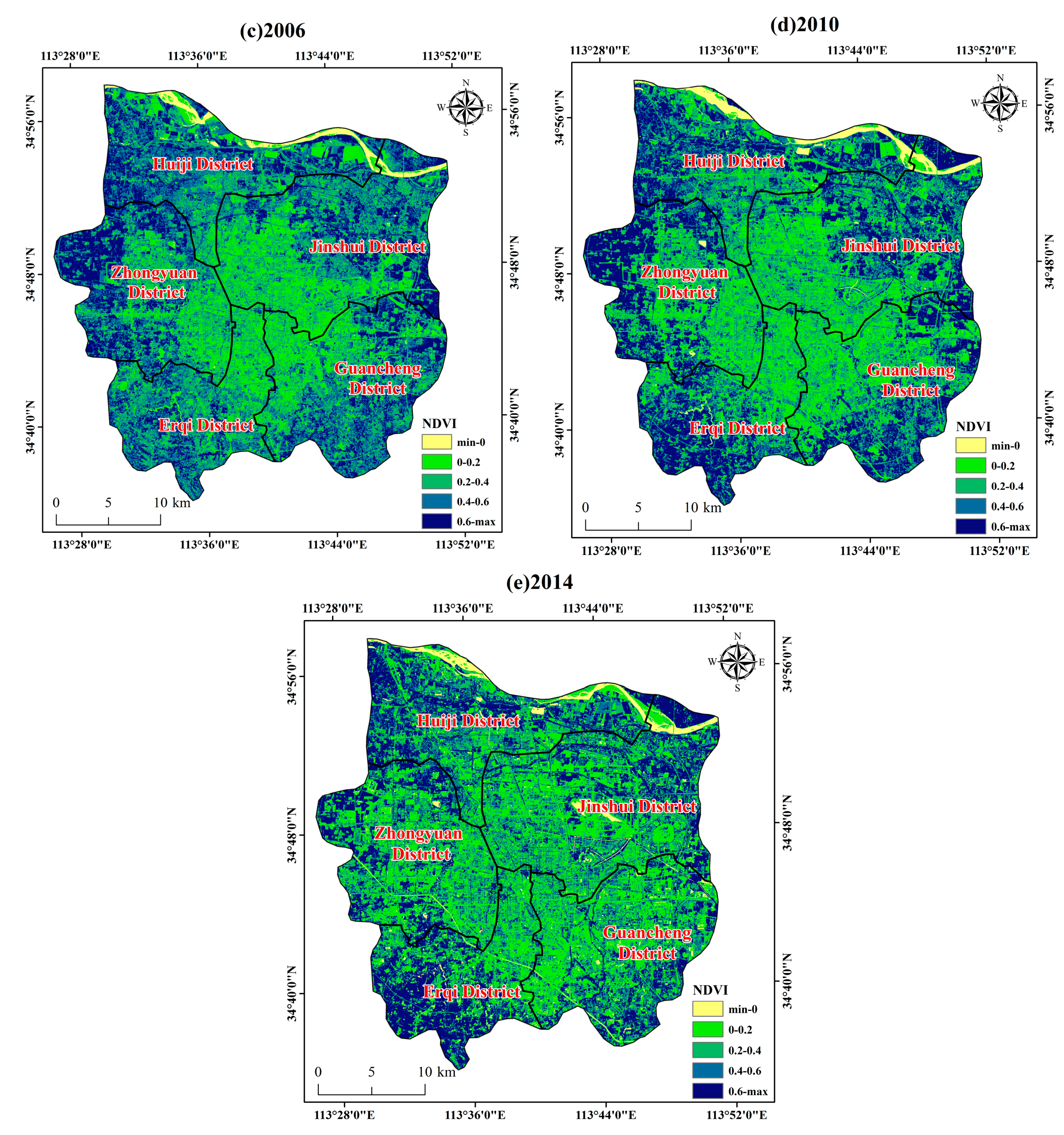
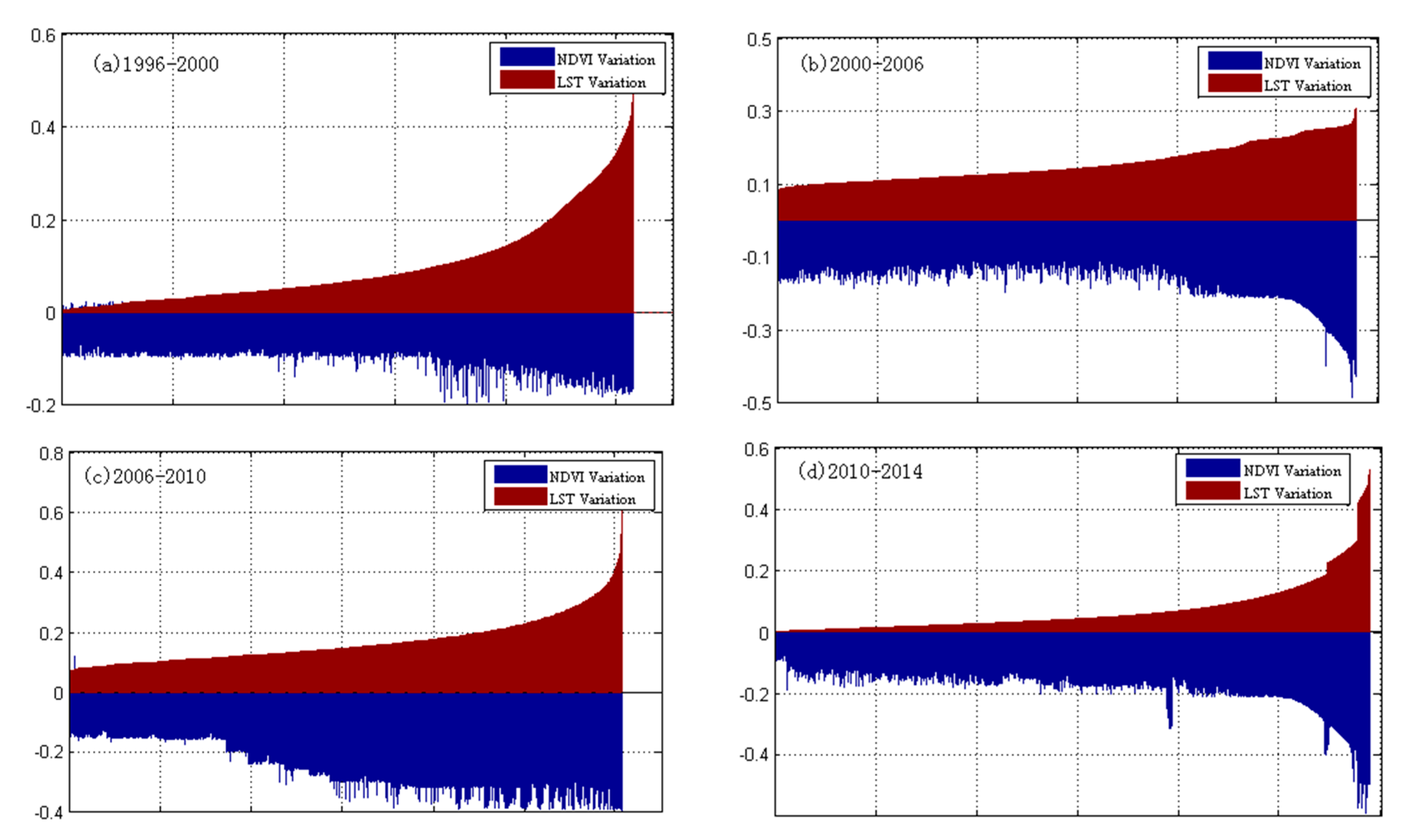
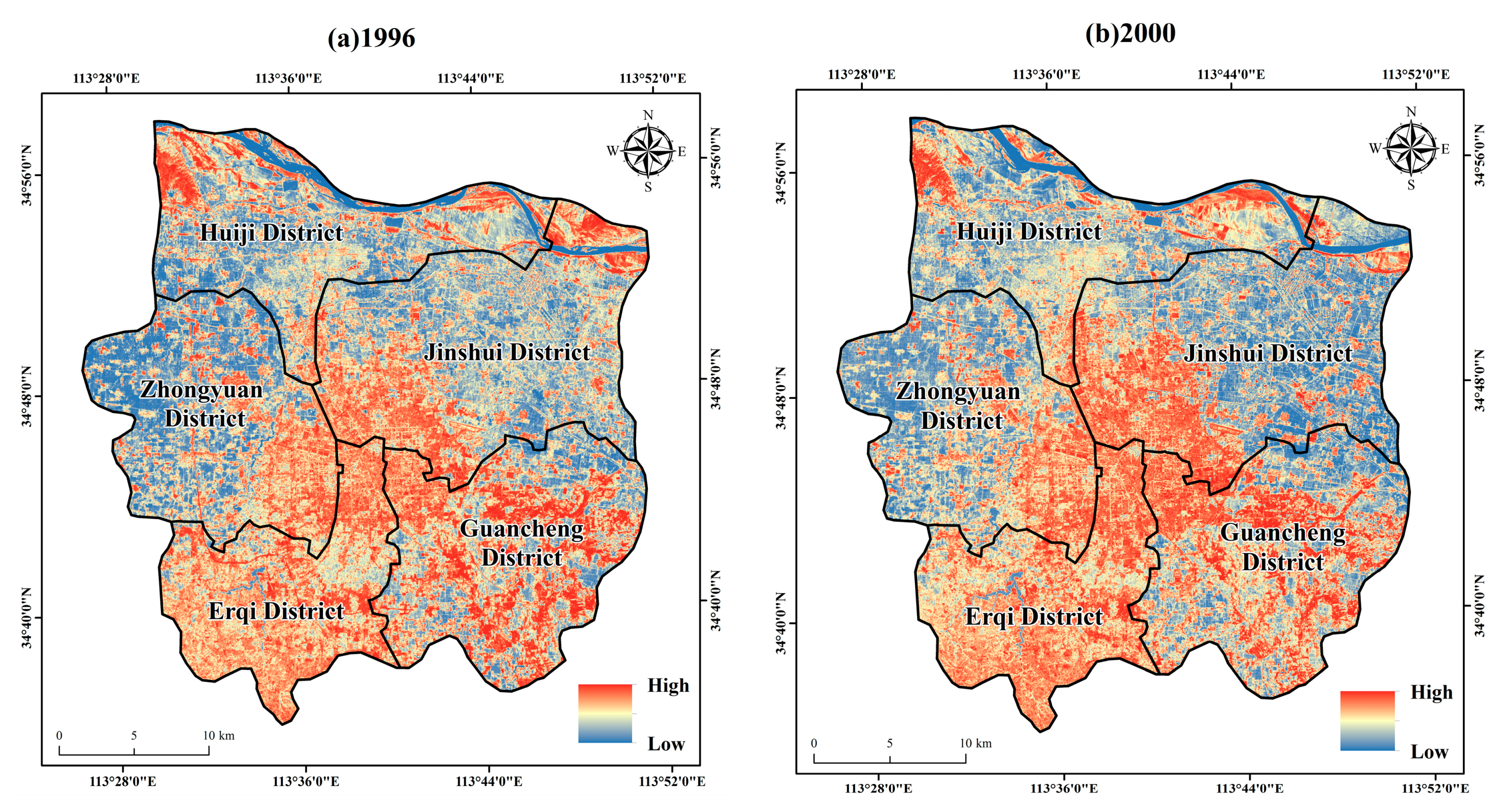
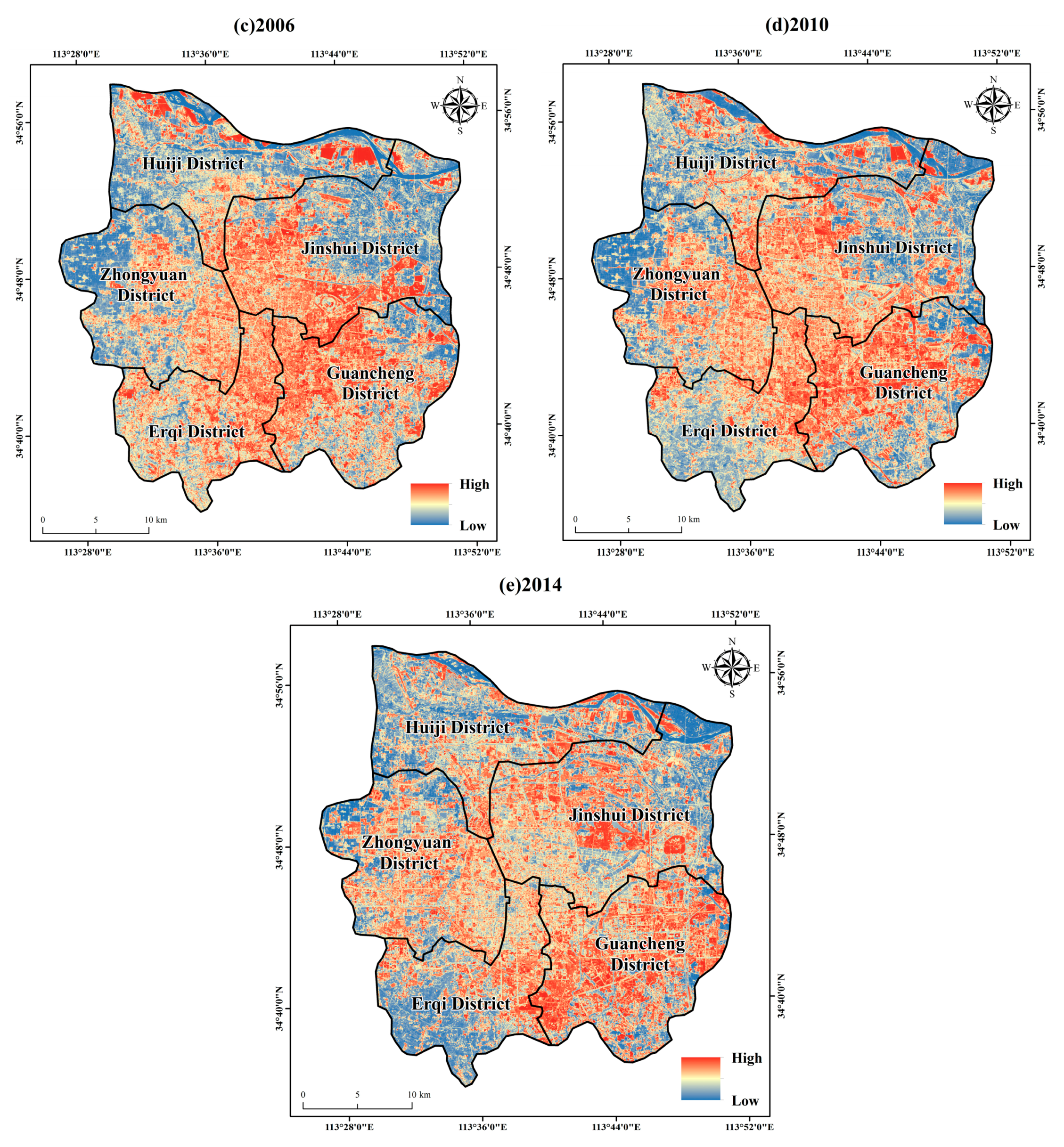
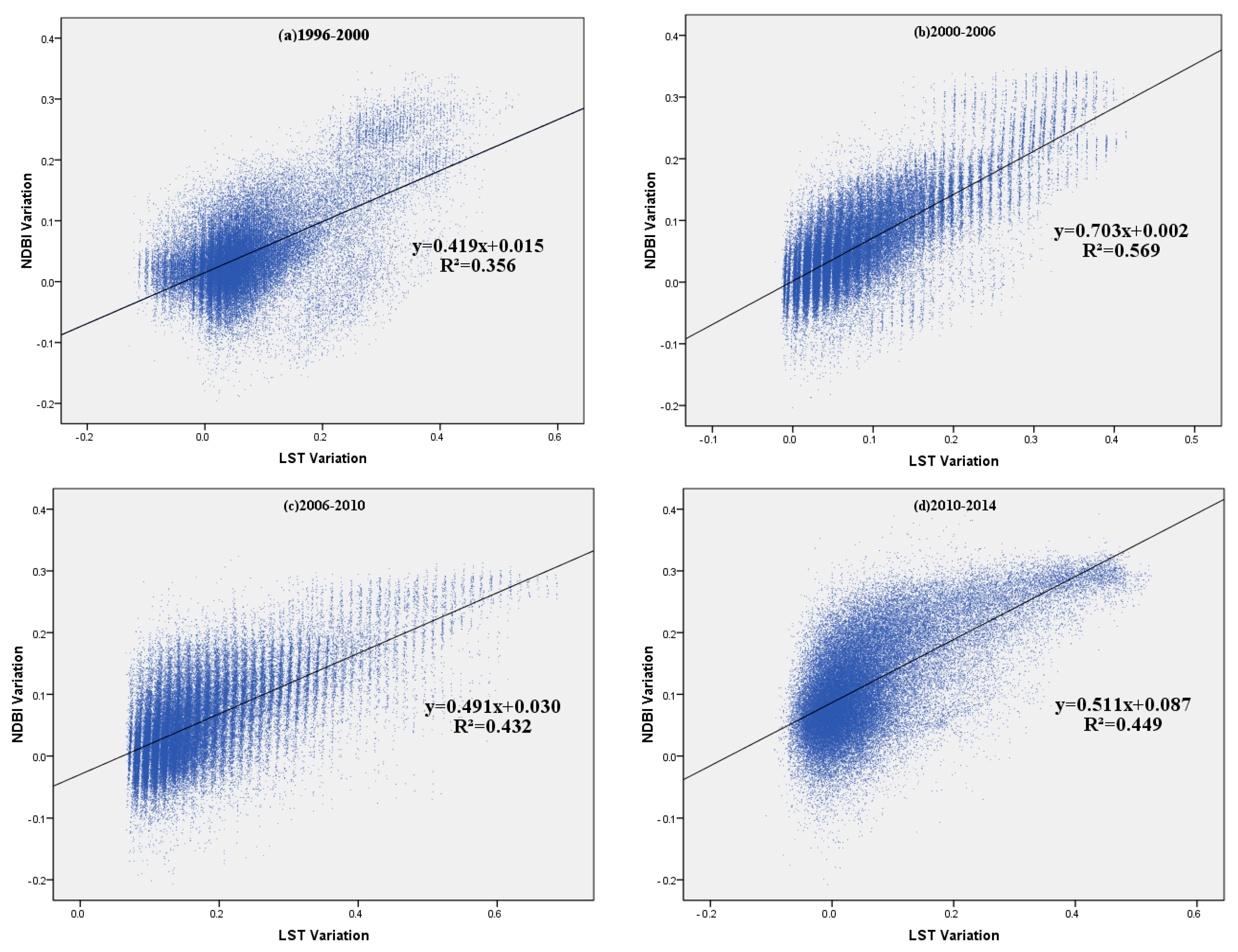
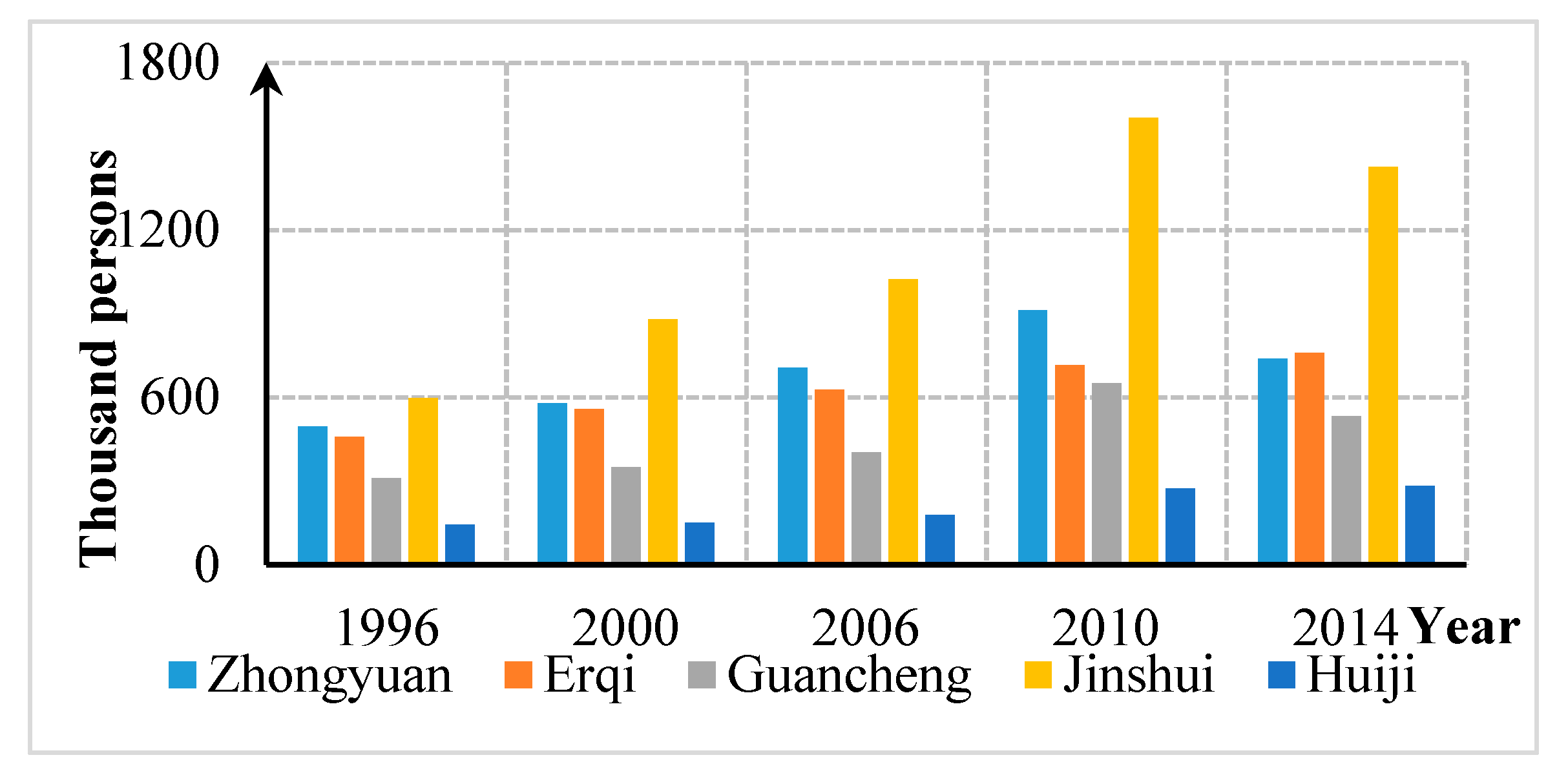
| Sensors | TM | ETM+ | OLI |
|---|---|---|---|
| K1 (W/m2·sr·µm) | 607.76 | 666.09 | 774.89 |
| K2 (K) | 1260.56 | 1282.71 | 1321.08 |
| Year | Maximum (°C) | Minimum (°C) | Amplitude (°C) | Average (°C) | Standard Deviation |
|---|---|---|---|---|---|
| 1996 | 40.8 | 13.2 | 27.6 | 29.2 | 4.1 |
| 2000 | 49.6 | 7.2 | 42.4 | 29.7 | 4.4 |
| 2006 | 45.0 | 12.0 | 32.9 | 29.0 | 3.4 |
| 2010 | 45.1 | 13.9 | 31.3 | 32.0 | 3.2 |
| 2014 | 45.3 | 18.8 | 26.4 | 32.7 | 2.6 |
| Driving Factor | Regression Equation | Correlation Coefficient | R2 | p |
|---|---|---|---|---|
| Population density | y = 0.668x + 0.188 | 0.762 | 0.580 | 0.01 |
| Urban construction | y = 0.698x + 0.083 | 0.723 | 0.523 | 0.01 |
| Industrial development | y = 0.818x + 0.077 | 0.774 | 0.600 | 0.01 |
© 2018 by the authors. Licensee MDPI, Basel, Switzerland. This article is an open access article distributed under the terms and conditions of the Creative Commons Attribution (CC BY) license (http://creativecommons.org/licenses/by/4.0/).
Share and Cite
Min, M.; Zhao, H.; Miao, C. Spatio-Temporal Evolution Analysis of the Urban Heat Island: A Case Study of Zhengzhou City, China. Sustainability 2018, 10, 1992. https://doi.org/10.3390/su10061992
Min M, Zhao H, Miao C. Spatio-Temporal Evolution Analysis of the Urban Heat Island: A Case Study of Zhengzhou City, China. Sustainability. 2018; 10(6):1992. https://doi.org/10.3390/su10061992
Chicago/Turabian StyleMin, Min, Hongbo Zhao, and Changhong Miao. 2018. "Spatio-Temporal Evolution Analysis of the Urban Heat Island: A Case Study of Zhengzhou City, China" Sustainability 10, no. 6: 1992. https://doi.org/10.3390/su10061992
APA StyleMin, M., Zhao, H., & Miao, C. (2018). Spatio-Temporal Evolution Analysis of the Urban Heat Island: A Case Study of Zhengzhou City, China. Sustainability, 10(6), 1992. https://doi.org/10.3390/su10061992





